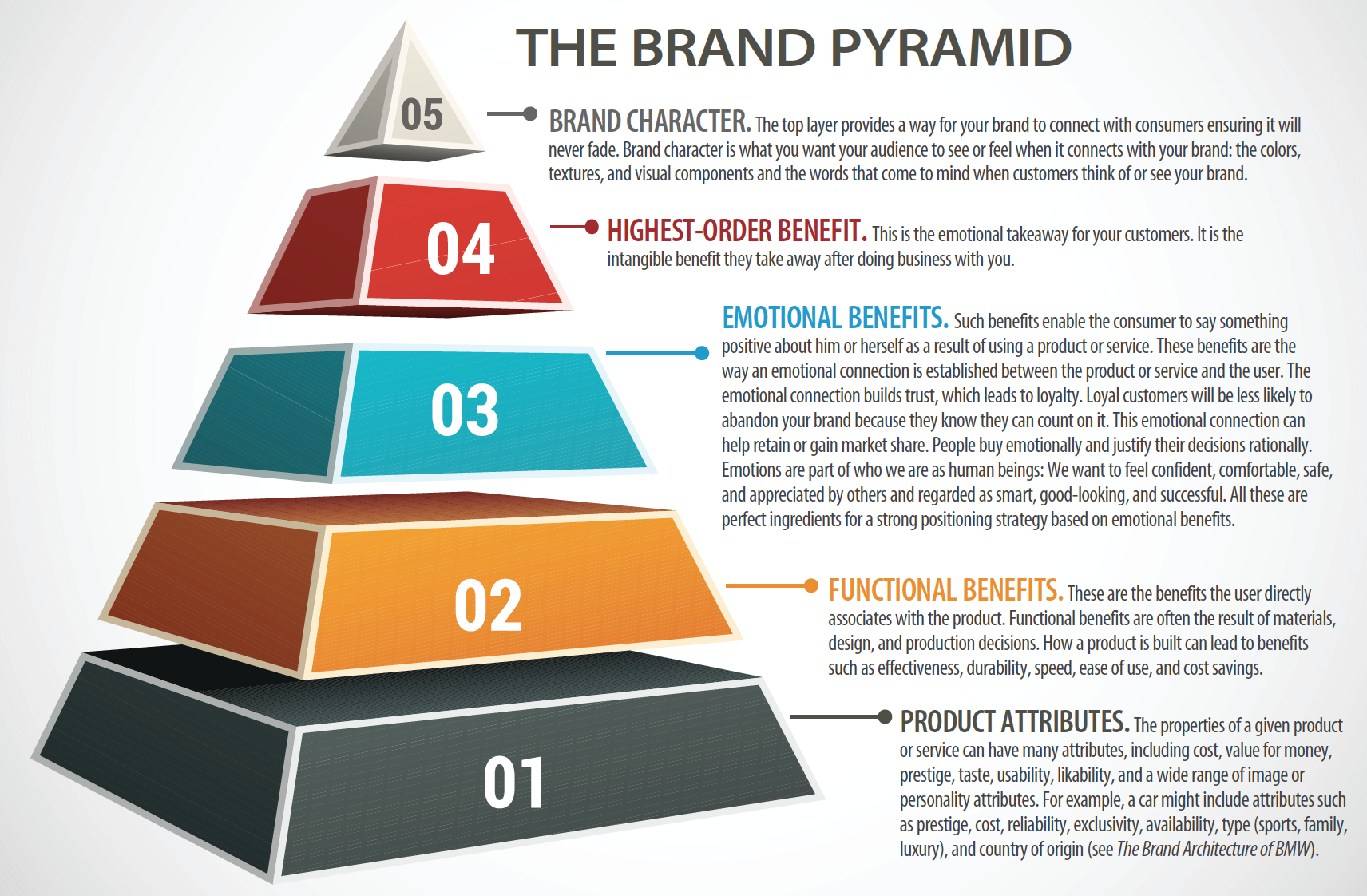

The word brand is widely used but often poorly understood. At times, it is used simply to refer to the trademarked name of a product. There is a difference, however, between a brand name and a brand, and this is mainly because there is more to the perception of distinctive products and services than their names.
AT A GLANCE
• Brands do not belong to companies. They belong to consumers who decide what the brand’s position is based on perceptions and experiences.
• Brand character provides a way for one’s brand to connect with consumers to ensure it will never fade.
• The positioning statement is used for product management, not direct-to-consumer communication.
• In cultural branding, the crowd advocates for your brand.
Marketing guru David Ogilvy has described brand as “the intangible sum of a product’s attributes.”1 In other words, there is a specific perception in customers’ minds regarding the qualities and attributes of a brand’s product or service.
What you must remember is this: your brand is what a customer thinks of when he or she hears your brand name. Your brand name exists objectively; people can see it, and it is fixed. Your brand exists only in someone’s mind. Brands do not belong to companies; they belong to consumers who decide what the brand’s position is based on perceptions and experiences.
Emotions influence many patients’ decisions. A great brand taps into these emotions, reaching out with a powerful connecting experience. Your brand is a story that should continue to evolve, creating the emotional context people need in order to find themselves in a larger experience.

YOUR BRAND ARCHITECTURE AND POSITIONING STATEMENT
How do you create your brand? Like building a house, creating a brand requires thoughtful planning, including developing your brand architecture and then fashioning a positioning statement for the brand.
Brand architecture. Your brand architecture should define what your brand is. (For an example, see The Brand Architecture of BMW.) It is best built in five related and evolving layers (see The Brand Pyramid).
Positioning statement. Your positioning statement defines the key message to be communicated. Positioning is a way to create a meaningful difference and stand out in the consumer’s mind. Generally, this requires focusing your efforts and making sacrifices to attract key consumers to your brand.
The Brand Architecture of BMW
The BMW brand illustrates each of the components of brand architecture. Buying a BMW includes the following:
Product attributes: rear-wheel drive, 50/50 weight distribution, low under steer, dynamic brake control, BMW driver training, and high price
Functional benefits: a drive that grips the road and feels responsive, light, and nimble; rapid acceleration; and a sense that “where you steer is where you go”
Emotional benefits accrue to the buyer: with the money one has spent and the car’s precision performance, the buyer feels powerful and in control; is wide-eyed with excitement, especially driving through the curves and on hills; thinks driving is playful and serious; and feels like a professional driver
Highest-order benefit: a powerful feeling of driving excitement in the ultimate driving machine Brand character: powerful, vigorous, and energized
The positioning statement is a discipline that consistently communicates your position in all you do: products, pricing, distribution, packaging, promotion, public relations, advertising, and online activities. To clarify, the positioning statement is used for product management; it describes your conscious choice of what to communicate about the brand and provides a guiding light for marketing activities. (For a how-to guide in creating this statement, see Anatomy of a Positioning Statement.) It is not used for direct-to-consumer communication. Nor should consumers ever see your positioning statement. They see instead your various marketing activities that are created based on the statement.
Consumers draw conclusions based on imagery, context, and reference as well as product information, and then they position the brand accordingly. Consumers differentiate brands based on the type of person who loves the brand, the context of the brand, and what the brand does for him or her.
Your positioning statement should articulate the following components:
No. 1. Key users. This distinct group is not all users, but rather just your core users—the brand’s avid fans. When consumers see the key user, they should understand the brand’s highest-order benefit (described in The Brand Pyramid). The key user is not a composite description of all users of the brand. Neither is it the only people who buy the brand nor necessarily the heavy user or the media target. Description of an effective key user provides a vivid, clear description of the person in a way that sets the stage for the brand.
No. 2. Frame of reference. This component is the stage on which your brand is the star. It links the brand to cases and contexts of appropriate use and connects with key users’ needs and desires. Examples of how to develop a frame of reference include a specific segment of a category or a new category such as, in the case of BMW, adults between the ages of 18 and 40 who are luxury car buyers. To help make your frame of reference effective, define it to your brand’s advantage, set it up to convey your distinctive benefit, ensure that it is relevant to the key user, keep it simple, and think beyond the obvious competitive set.
No. 3. A distinctive benefit. There are two types of distinctive benefit, functional and emotional, as described earlier. To make the distinctive benefit—what your brand does for the consumer—effective, be sure that your product differentiates you from your competition, appeals to the key user, and is consistent with your brand’s character.
No. 4. A reason to believe. This reason specifically and logically supports the distinctive benefit and offers proof so that the consumer can believe that the distinctive benefit will be delivered. It also gives credibility to the brand’s promise and provides a point of distinction for a generic benefit. Types of reasons to believe include technical performance, quality of or special ingredients, endorsements, visual demonstrations, special product features and aesthetics, and trusted sources.
To make your positioning statement effective, be distinctive. Even without hearing your brand name, people should know which brand it is. Tell a complete story so that all elements flow and make sense. Finally, keep it simple so that your entire team can understand, remember, and keep the positioning statement top of mind.
The positioning statement guides all marketing activities. Because, as they say, “everything communicates,” be sure it all communicates what you want it to communicate.
HARNESSING THE POWER OF THE CROWD
The advent of social media has introduced challenges and opportunities to resonate with audiences and optimize your brand equity. Conventional models of so-called mindshare and purposed branding used in traditional mass media are less effective in the rapidly evolving world of social media.
The proliferation of social networks and digital communities has redefined brand experience and the notion of influence. To reach customers in this context, it is helpful to understand the crowd-cultures being created by social media platforms. By identifying, understanding, and addressing the growing expectations of these crowds, we can introduce a new type of branding opportunity: cultural branding, in which the crowd advocates for your brand.
Developing and nurturing a strong brand can help you harness the power of the crowd using cultural branding. Tips to consider include the following:
No. 1. Challenge convention, and become innovative. Conservative brand bureaucracies stifle innovation, and they produce brand spam that often fails to resonate with social media. However, digital crowds generated by social media are inherently innovative cultures. By tapping into their insights, you might find a natural inlet to innovation that resonates.
No. 2. Uncover opportunity by researching beliefs and attitudes that have gained traction among social media crowd-cultures. By targeting novel ideologies embedded in these cultures, your brand has a chance to stand out, which can lead to branding breakthroughs.
ANATOMY OF A POSITIONING STATEMENT
Any brand can create a positioning statement by replacing the bold words below with words that illustrate its brand architecture.
Especially for KEY USERS, THE BRAND is the FRAME OF REFERENCE that DISTINCTIVE BENEFITS because REASON TO BELIEVE.
Example: BMW positioning statement
Especially for serious drivers, BMW is the ultimate driving machine that delivers driving excitement because its design integrates the latest, most ingenious performance technology available.
No. 3. Target the crowd-cultures by becoming a passionate advocate for their beliefs. Build trust and loyalty by championing their causes, and cultivate perceptions and experiences. This allows you to generate the emotional benefit that helps to gain and retain market share and bolsters your brand character—the apex of the brand pyramid.
No. 4. Disseminate the crowd ideology by converting marginal ideologies into mainstream movements. Use your influence to advance your crowd-cultures’ innovative ideologies by communicating them to a mass audience. In the process, you will gain crowd-culture support. Become an evangelist for your crowd-culture’s ideology, and your crowd-culture will become an evangelist for your brand.
No. 5. Innovate deliberately by engaging in constant dialogue with your audiences. A brand is a story that is never completely told. By engaging in the ongoing discourse couched in your crowd’s innovative ideologies, you are continuing to tell your story and theirs. Being an active advocate in an ongoing discussion gives you a distinctive voice in an otherwise saturated social media environment.
CONCLUSION
Remember that your brand resides in your customers, your brand architecture defines what your brand is, your positioning statement defines the key message your brand should communicate to consumers, and social media can reveal the innovative ideologies that leverage both your brand and your brand architecture.
Branding is often confused with marketing. Branding is strategic; marketing is tactical. Whereas marketing unearths and activates buyers, branding makes loyal customers, advocates, and even evangelists out of those who buy. Branding is as important to your success as financial performance, a clear vision, and hiring quality personnel.
1. Ogilvy D. Ogilvy on Advertising. New York: Vintage; 1983.
P. Lloyd Hildebrand, MD
• professor of ophthalmology and director of Global Eye Care Fellowship, Dean McGee Eye Institute (https://dmei.org/), University of Oklahoma College of Medicine
• lloyd-hildebrand@ouhsc.edu
• financial interest: none acknowledged
Veronica Jacob, JD
• founder, Meraki Ventures
• veronica.jacob@alumni.duke.edu
• financial interest: none acknowledged


